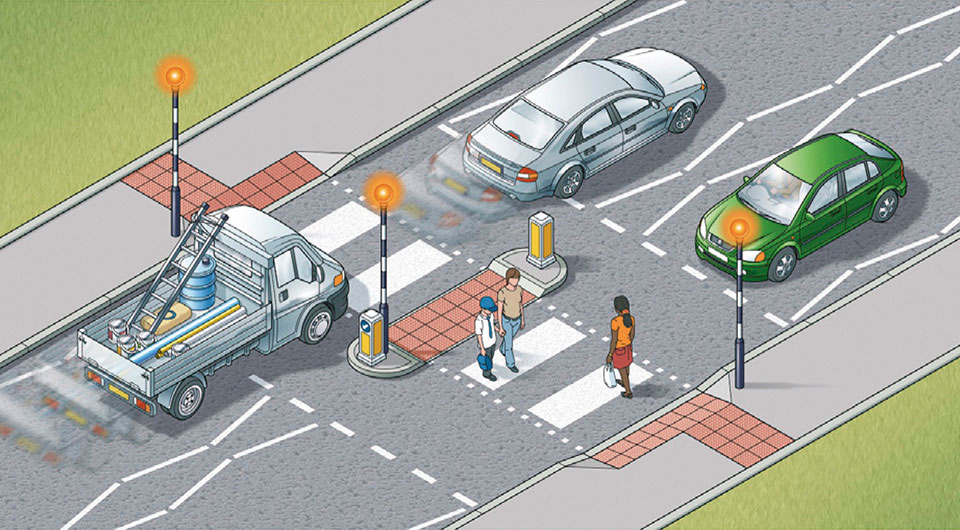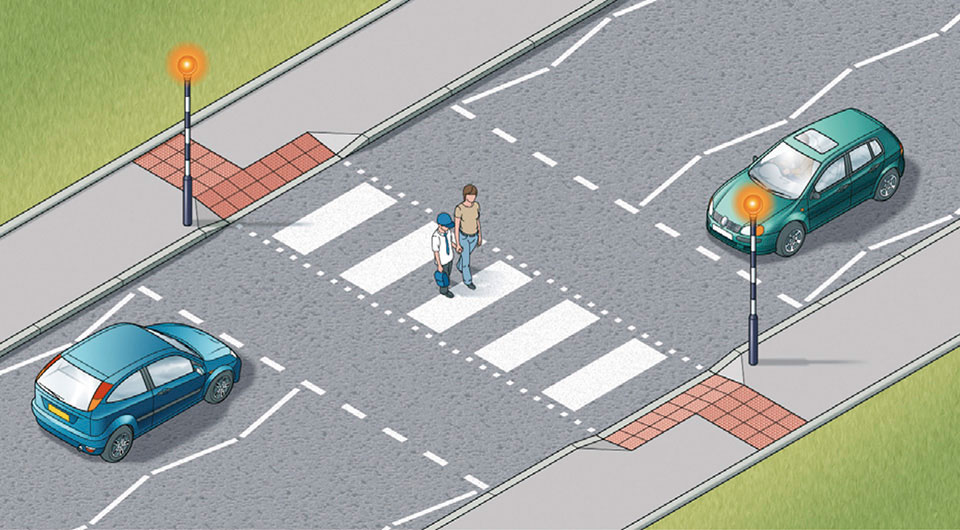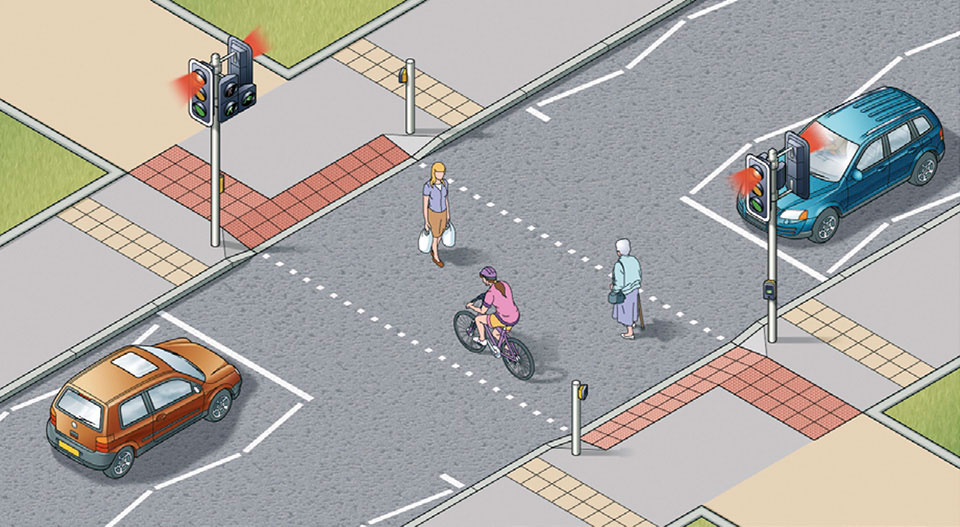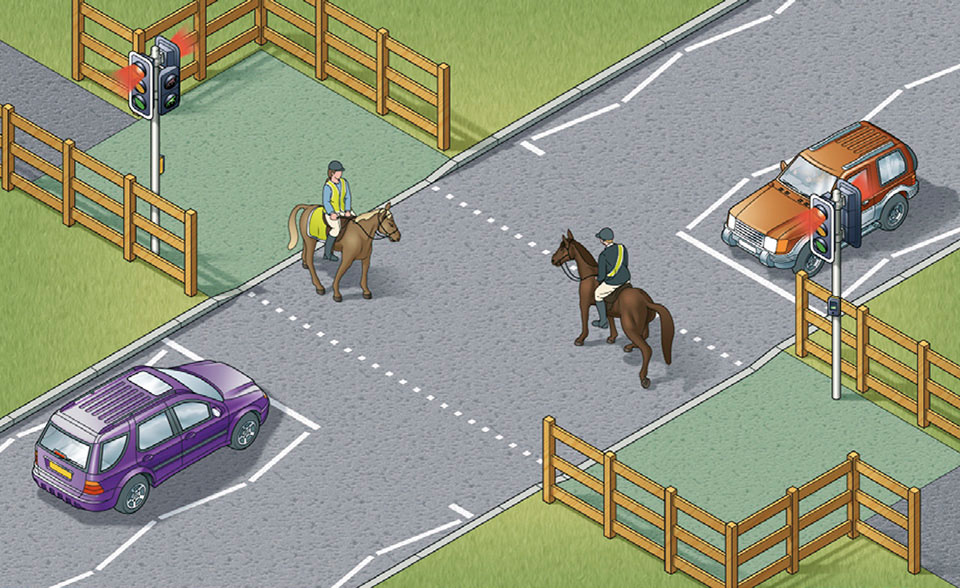Types of pedestrian crossings
When learning to drive a focus of a lesson can be based around pedestrian crossings. During your driving test, the examiner will be looking at how you deal with or react to pedestrian crossings. They want to make sure that you are planning ahead, showing awareness and responding to them them in the safest possible way.
Pedestrian crossings get put into two main categories – uncontrolled and traffic light controlled.
For all crossings:
-In queuing traffic, you should keep the crossing clear.
On approach to a crossing there will be white zigzag lines on both sides of the road to highlight there is a pedestrian crossing ahead – these also prevent people parking at any time and is a place you make no attempt to overtake.
You should take extra care where the view of either side of the crossing is blocked by queuing traffic or incorrectly parked vehicles. Pedestrians may be crossing between stationary vehicles.
Allow pedestrians plenty of time to cross and do not harass them by revving your engine or edging forward.
Zebra Crossing
When learning to drive with 4front Driving School you are taught to look ahead, plan ahead and be aware of zebra crossings and how they work. They are uncontrolled crossings which are marked by black and white stripes on the road, you will notice two yellow flashing beacons in the distance when approach this type of crossing which gives you time to plan and prepare. On approach to the zebra crossing there will be white zigzag lines on both sides of the road to highlight there is a pedestrian crossing ahead – these also prevent people parking at any time and is a place you make no attempt to overtake.
On your approach to the zebra crossing, you need to look out for anyone waiting at the crossing ready to cross, on the crossing, alreadycrossing, or if there is a someone walking towards the crossing as you approach who is likely to cross. Depending on what the situation is you need to either slow down or come to a complete stop. Make sure that you allow the pedestrian to fully cross the road before you set off again.
Allow more time for stopping on wet or icy roads
Do not wave or use your horn to invite pedestrians across; this could be dangerous if another vehicle is approaching
zebra crossing with a central island is two separate crossings

Signal-controlled crossings
A signal-controlled crossing is a crossing that is controlled by traffic lights. Below are some of the most common controlled crossings that you will come across.
Pelican Crossing
Pelican crossings. These are signal-controlled crossings where flashing amber follows the red ‘Stop’ light. You MUST stop when the red light shows. When the amber light is flashing, you MUST give way to any pedestrians on the crossing. If the amber light is flashing and there are no pedestrians on the crossing, you may proceed with caution.
Pelican crossings which go straight across the road are one crossing, even when there is a central island. You MUST wait for pedestrians who are crossing from the other side of the island.
Give way to anyone still crossing after the signal for vehicles has changed to green. This advice applies to all crossings.
Puffin Crossings
Puffin crossings are intelligent crossings unlike pelican crossings. They have sensors on top of the lights and in the pavement so they know when a person has finished crossing. In this way, the lights will only stay red as long as it takes for the person to cross and will go back to green once that person is across.
This can help to keep traffic moving during busy times, it also has the benefit of giving pedestrians as long as they need to cross without being rushed by a timer.
However there is no amber flashing light. Instead you will get a red and amber combined light sequence before they turn green. The red and amber means stop, do not go, you can however get your vehicle ready to go and then proceed when it is safe to do so.
Toucan Crossings
Toucan crossings enable cyclists and pedestrians to cross the road at the same point. Two Can Cross. A cyclist can cross without having to get off their bike as it is usually built into a cycle lane. Toucan crossings have a green and red bike alongside the red and green man lights for the pedestrians. They also have sensors and no amber flashing lights.
Equestrian / Pegasus Crossings
As the name suggests, equestrian crossings are designed for horse riders. They allow a rider to stay on their horse as the button to request to cross is higher than normal.
Approaching pedestrian crossings as a driver
Identifying Pedestrian Crossings
As a careful and safe driver, you will always be in aware of what is coming up on the road ahead of you. In this way, you will be able to identify the indications that a pedestrian crossing is approaching – this could be in the form of a triangular warning sign, flashing yellow beacons or zigzag markings as you approach.
Mirror Signal Position Speed Look
Now you have identified the crossing, you need to go through the MSPSL routine so that you can drive up to the crossing in a safe way.
- Mirrors – look in all of your mirrors so that you can see what is behind you, and be able to make an accurate assessment of the distance and speed of the traffic that is following you
- Signal – the only signal you need will be your brake lights which will come on as you slow down, this will indicate to other drivers that are behind you that you are reducing your speed.
- Position your vehicle so that you are within your road markings, lane markings and correct position at the crossing markers. You will need to stop at the solid white line. Not after.
- Speed - plan ahead so that you can react early and reduce the speed of the vehicle down slowly and gradually, reducing the risk of being rear ended. You will probably need to bring the vehicle to a stoom
- Look out for the pedestrians, making sure they have cleared the crossing and look out for the changes of traffic lights so that you are ready to respond.



